West Coast University: Healthcare Research Critique, Week 7 Assignment
VerifiedAdded on 2022/09/29
|9
|2085
|21
Report
AI Summary
This report offers a critical evaluation of a research study by Lu, Senthilselvan, Joffe, and Beach (2014) focusing on the effectiveness of safety-engineered devices (SEDs) in reducing sharp object injuries among healthcare workers. The critique examines the study's methodology, including its quantitative approach, reliance on pre-existing data, and statistical analysis using Poisson regression. It assesses the strengths, such as the long-term data collection period, and weaknesses, such as the lack of a theoretical framework and potential biases in data collection. The report discusses the study's findings, highlighting the impact of SEDs in reducing injury rates, and its implications for nursing practice, including the need for improved SED design and individual responsibility in preventing injuries. The critique also addresses limitations, such as the inability to generalize findings due to the use of surveillance data, and offers recommendations for future research and practice improvements.
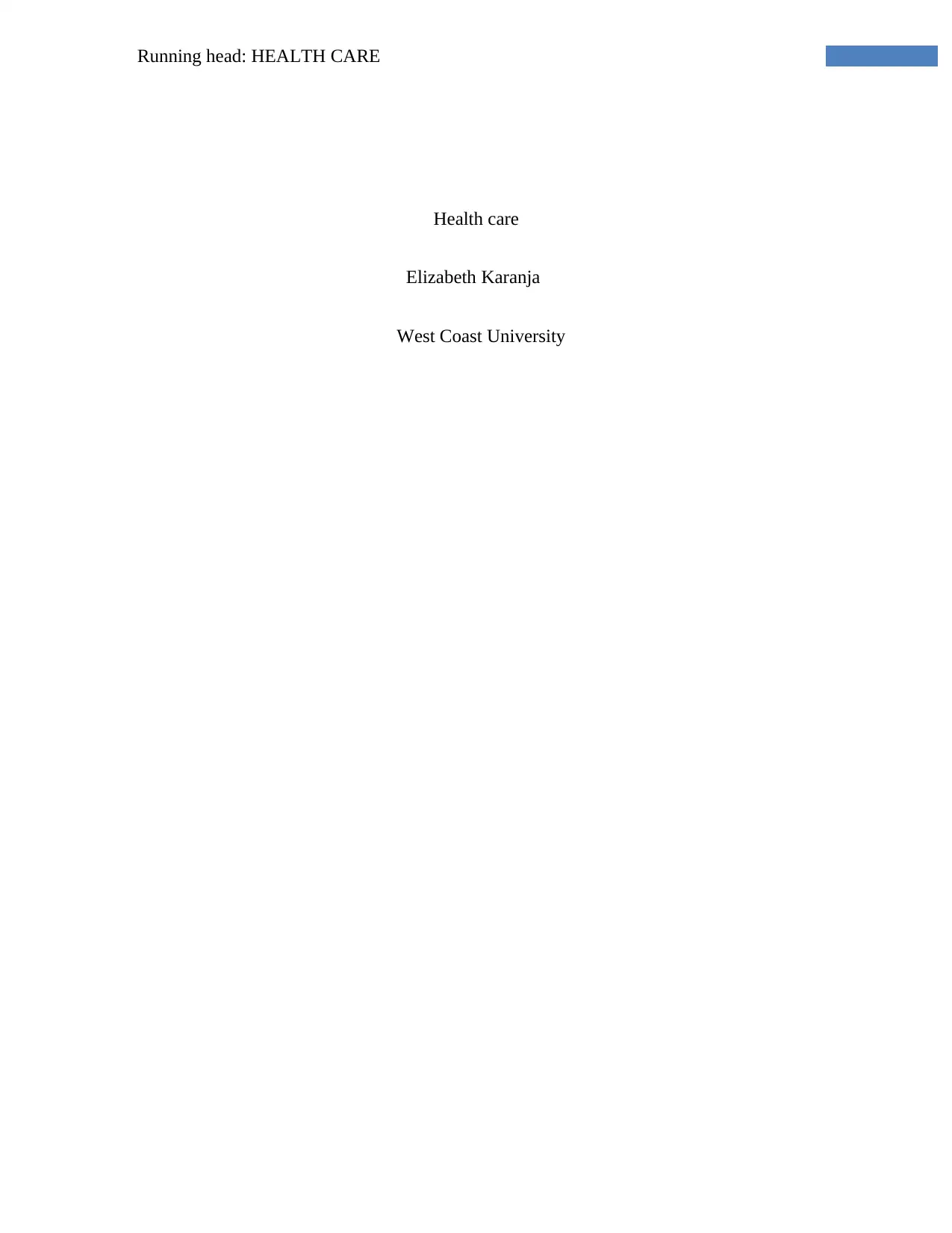
Running head: HEALTH CARE
Health care
Elizabeth Karanja
West Coast University
Health care
Elizabeth Karanja
West Coast University
Paraphrase This Document
Need a fresh take? Get an instant paraphrase of this document with our AI Paraphraser
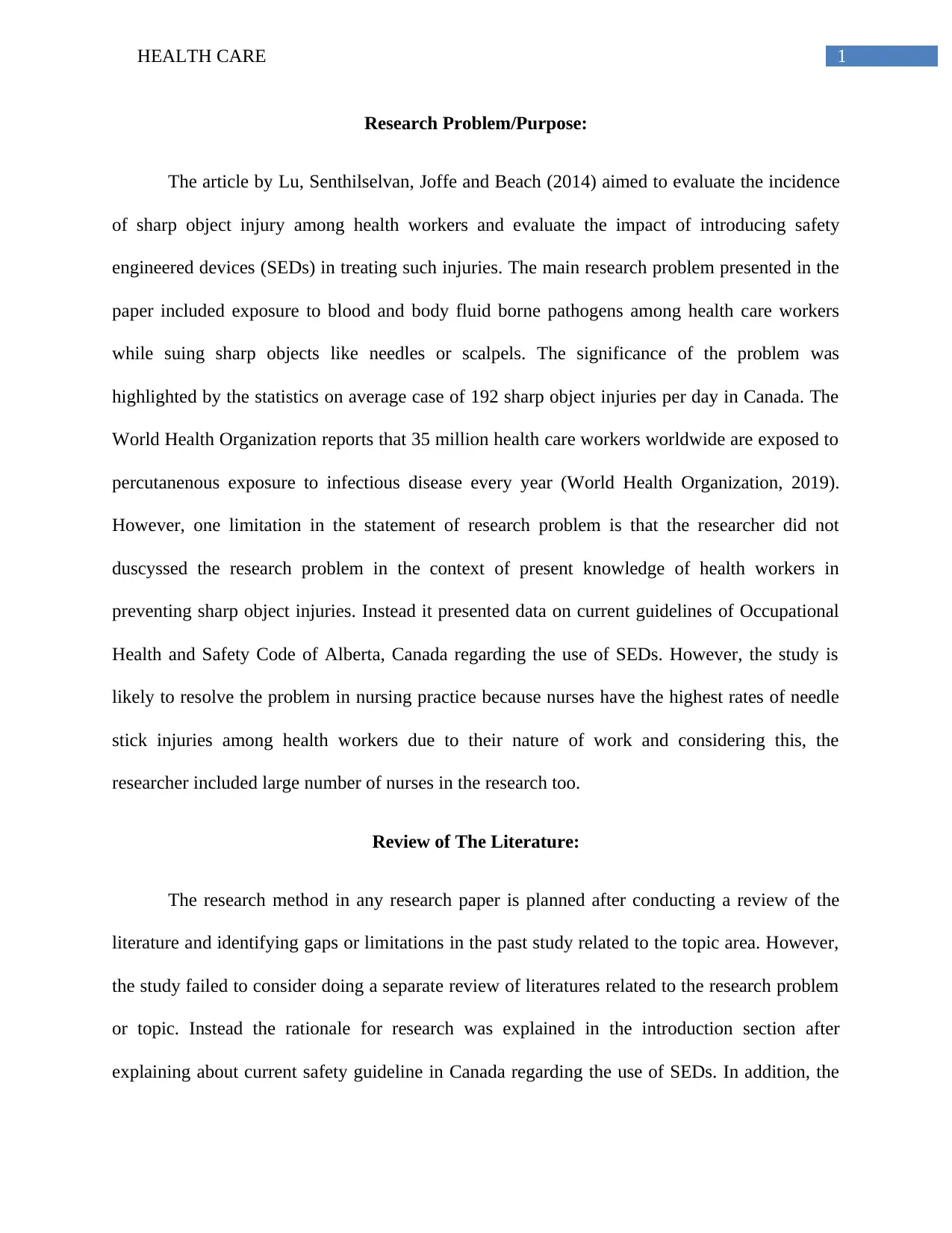
1HEALTH CARE
Research Problem/Purpose:
The article by Lu, Senthilselvan, Joffe and Beach (2014) aimed to evaluate the incidence
of sharp object injury among health workers and evaluate the impact of introducing safety
engineered devices (SEDs) in treating such injuries. The main research problem presented in the
paper included exposure to blood and body fluid borne pathogens among health care workers
while suing sharp objects like needles or scalpels. The significance of the problem was
highlighted by the statistics on average case of 192 sharp object injuries per day in Canada. The
World Health Organization reports that 35 million health care workers worldwide are exposed to
percutanenous exposure to infectious disease every year (World Health Organization, 2019).
However, one limitation in the statement of research problem is that the researcher did not
duscyssed the research problem in the context of present knowledge of health workers in
preventing sharp object injuries. Instead it presented data on current guidelines of Occupational
Health and Safety Code of Alberta, Canada regarding the use of SEDs. However, the study is
likely to resolve the problem in nursing practice because nurses have the highest rates of needle
stick injuries among health workers due to their nature of work and considering this, the
researcher included large number of nurses in the research too.
Review of The Literature:
The research method in any research paper is planned after conducting a review of the
literature and identifying gaps or limitations in the past study related to the topic area. However,
the study failed to consider doing a separate review of literatures related to the research problem
or topic. Instead the rationale for research was explained in the introduction section after
explaining about current safety guideline in Canada regarding the use of SEDs. In addition, the
Research Problem/Purpose:
The article by Lu, Senthilselvan, Joffe and Beach (2014) aimed to evaluate the incidence
of sharp object injury among health workers and evaluate the impact of introducing safety
engineered devices (SEDs) in treating such injuries. The main research problem presented in the
paper included exposure to blood and body fluid borne pathogens among health care workers
while suing sharp objects like needles or scalpels. The significance of the problem was
highlighted by the statistics on average case of 192 sharp object injuries per day in Canada. The
World Health Organization reports that 35 million health care workers worldwide are exposed to
percutanenous exposure to infectious disease every year (World Health Organization, 2019).
However, one limitation in the statement of research problem is that the researcher did not
duscyssed the research problem in the context of present knowledge of health workers in
preventing sharp object injuries. Instead it presented data on current guidelines of Occupational
Health and Safety Code of Alberta, Canada regarding the use of SEDs. However, the study is
likely to resolve the problem in nursing practice because nurses have the highest rates of needle
stick injuries among health workers due to their nature of work and considering this, the
researcher included large number of nurses in the research too.
Review of The Literature:
The research method in any research paper is planned after conducting a review of the
literature and identifying gaps or limitations in the past study related to the topic area. However,
the study failed to consider doing a separate review of literatures related to the research problem
or topic. Instead the rationale for research was explained in the introduction section after
explaining about current safety guideline in Canada regarding the use of SEDs. In addition, the
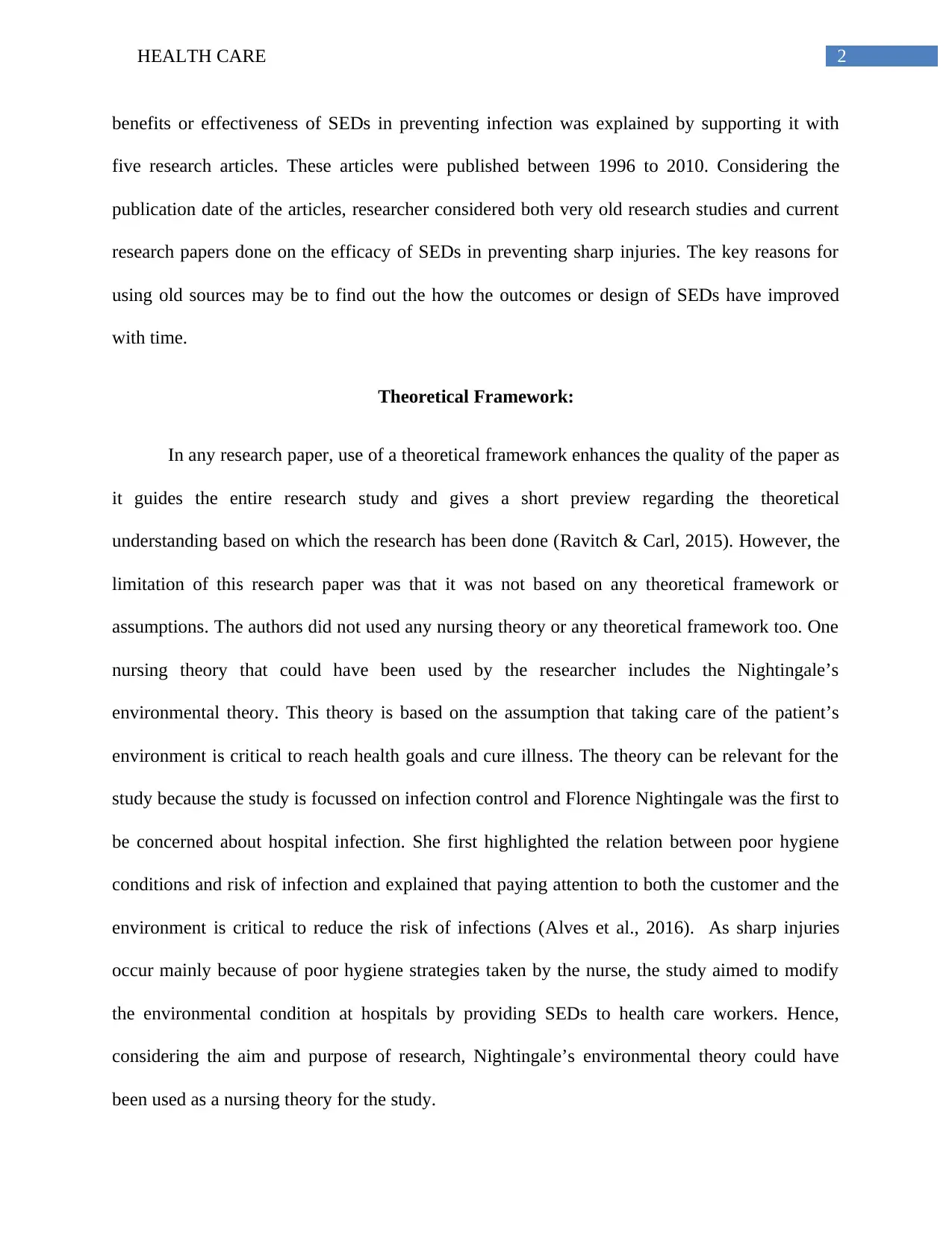
2HEALTH CARE
benefits or effectiveness of SEDs in preventing infection was explained by supporting it with
five research articles. These articles were published between 1996 to 2010. Considering the
publication date of the articles, researcher considered both very old research studies and current
research papers done on the efficacy of SEDs in preventing sharp injuries. The key reasons for
using old sources may be to find out the how the outcomes or design of SEDs have improved
with time.
Theoretical Framework:
In any research paper, use of a theoretical framework enhances the quality of the paper as
it guides the entire research study and gives a short preview regarding the theoretical
understanding based on which the research has been done (Ravitch & Carl, 2015). However, the
limitation of this research paper was that it was not based on any theoretical framework or
assumptions. The authors did not used any nursing theory or any theoretical framework too. One
nursing theory that could have been used by the researcher includes the Nightingale’s
environmental theory. This theory is based on the assumption that taking care of the patient’s
environment is critical to reach health goals and cure illness. The theory can be relevant for the
study because the study is focussed on infection control and Florence Nightingale was the first to
be concerned about hospital infection. She first highlighted the relation between poor hygiene
conditions and risk of infection and explained that paying attention to both the customer and the
environment is critical to reduce the risk of infections (Alves et al., 2016). As sharp injuries
occur mainly because of poor hygiene strategies taken by the nurse, the study aimed to modify
the environmental condition at hospitals by providing SEDs to health care workers. Hence,
considering the aim and purpose of research, Nightingale’s environmental theory could have
been used as a nursing theory for the study.
benefits or effectiveness of SEDs in preventing infection was explained by supporting it with
five research articles. These articles were published between 1996 to 2010. Considering the
publication date of the articles, researcher considered both very old research studies and current
research papers done on the efficacy of SEDs in preventing sharp injuries. The key reasons for
using old sources may be to find out the how the outcomes or design of SEDs have improved
with time.
Theoretical Framework:
In any research paper, use of a theoretical framework enhances the quality of the paper as
it guides the entire research study and gives a short preview regarding the theoretical
understanding based on which the research has been done (Ravitch & Carl, 2015). However, the
limitation of this research paper was that it was not based on any theoretical framework or
assumptions. The authors did not used any nursing theory or any theoretical framework too. One
nursing theory that could have been used by the researcher includes the Nightingale’s
environmental theory. This theory is based on the assumption that taking care of the patient’s
environment is critical to reach health goals and cure illness. The theory can be relevant for the
study because the study is focussed on infection control and Florence Nightingale was the first to
be concerned about hospital infection. She first highlighted the relation between poor hygiene
conditions and risk of infection and explained that paying attention to both the customer and the
environment is critical to reduce the risk of infections (Alves et al., 2016). As sharp injuries
occur mainly because of poor hygiene strategies taken by the nurse, the study aimed to modify
the environmental condition at hospitals by providing SEDs to health care workers. Hence,
considering the aim and purpose of research, Nightingale’s environmental theory could have
been used as a nursing theory for the study.
⊘ This is a preview!⊘
Do you want full access?
Subscribe today to unlock all pages.

Trusted by 1+ million students worldwide
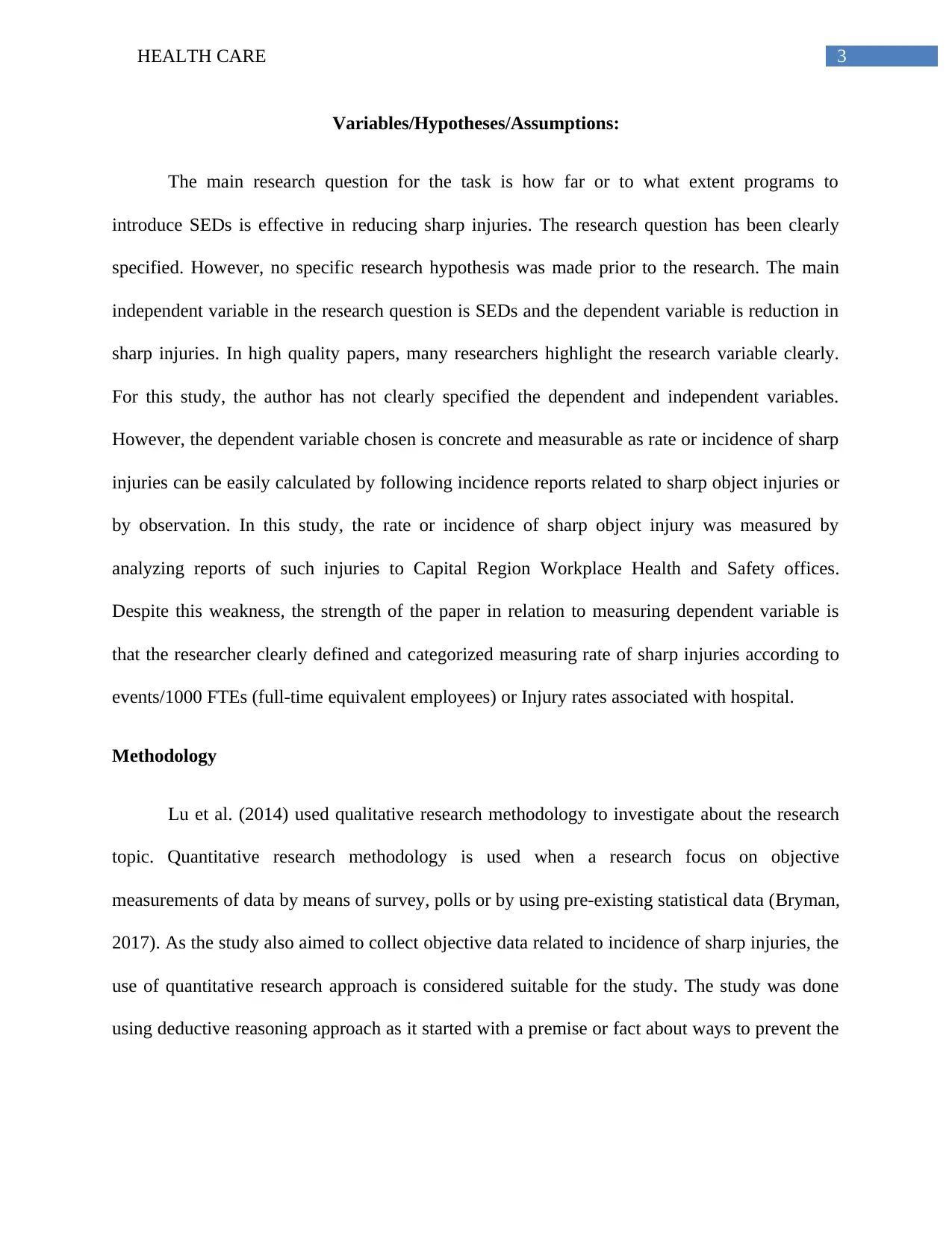
3HEALTH CARE
Variables/Hypotheses/Assumptions:
The main research question for the task is how far or to what extent programs to
introduce SEDs is effective in reducing sharp injuries. The research question has been clearly
specified. However, no specific research hypothesis was made prior to the research. The main
independent variable in the research question is SEDs and the dependent variable is reduction in
sharp injuries. In high quality papers, many researchers highlight the research variable clearly.
For this study, the author has not clearly specified the dependent and independent variables.
However, the dependent variable chosen is concrete and measurable as rate or incidence of sharp
injuries can be easily calculated by following incidence reports related to sharp object injuries or
by observation. In this study, the rate or incidence of sharp object injury was measured by
analyzing reports of such injuries to Capital Region Workplace Health and Safety offices.
Despite this weakness, the strength of the paper in relation to measuring dependent variable is
that the researcher clearly defined and categorized measuring rate of sharp injuries according to
events/1000 FTEs (full-time equivalent employees) or Injury rates associated with hospital.
Methodology
Lu et al. (2014) used qualitative research methodology to investigate about the research
topic. Quantitative research methodology is used when a research focus on objective
measurements of data by means of survey, polls or by using pre-existing statistical data (Bryman,
2017). As the study also aimed to collect objective data related to incidence of sharp injuries, the
use of quantitative research approach is considered suitable for the study. The study was done
using deductive reasoning approach as it started with a premise or fact about ways to prevent the
Variables/Hypotheses/Assumptions:
The main research question for the task is how far or to what extent programs to
introduce SEDs is effective in reducing sharp injuries. The research question has been clearly
specified. However, no specific research hypothesis was made prior to the research. The main
independent variable in the research question is SEDs and the dependent variable is reduction in
sharp injuries. In high quality papers, many researchers highlight the research variable clearly.
For this study, the author has not clearly specified the dependent and independent variables.
However, the dependent variable chosen is concrete and measurable as rate or incidence of sharp
injuries can be easily calculated by following incidence reports related to sharp object injuries or
by observation. In this study, the rate or incidence of sharp object injury was measured by
analyzing reports of such injuries to Capital Region Workplace Health and Safety offices.
Despite this weakness, the strength of the paper in relation to measuring dependent variable is
that the researcher clearly defined and categorized measuring rate of sharp injuries according to
events/1000 FTEs (full-time equivalent employees) or Injury rates associated with hospital.
Methodology
Lu et al. (2014) used qualitative research methodology to investigate about the research
topic. Quantitative research methodology is used when a research focus on objective
measurements of data by means of survey, polls or by using pre-existing statistical data (Bryman,
2017). As the study also aimed to collect objective data related to incidence of sharp injuries, the
use of quantitative research approach is considered suitable for the study. The study was done
using deductive reasoning approach as it started with a premise or fact about ways to prevent the
Paraphrase This Document
Need a fresh take? Get an instant paraphrase of this document with our AI Paraphraser
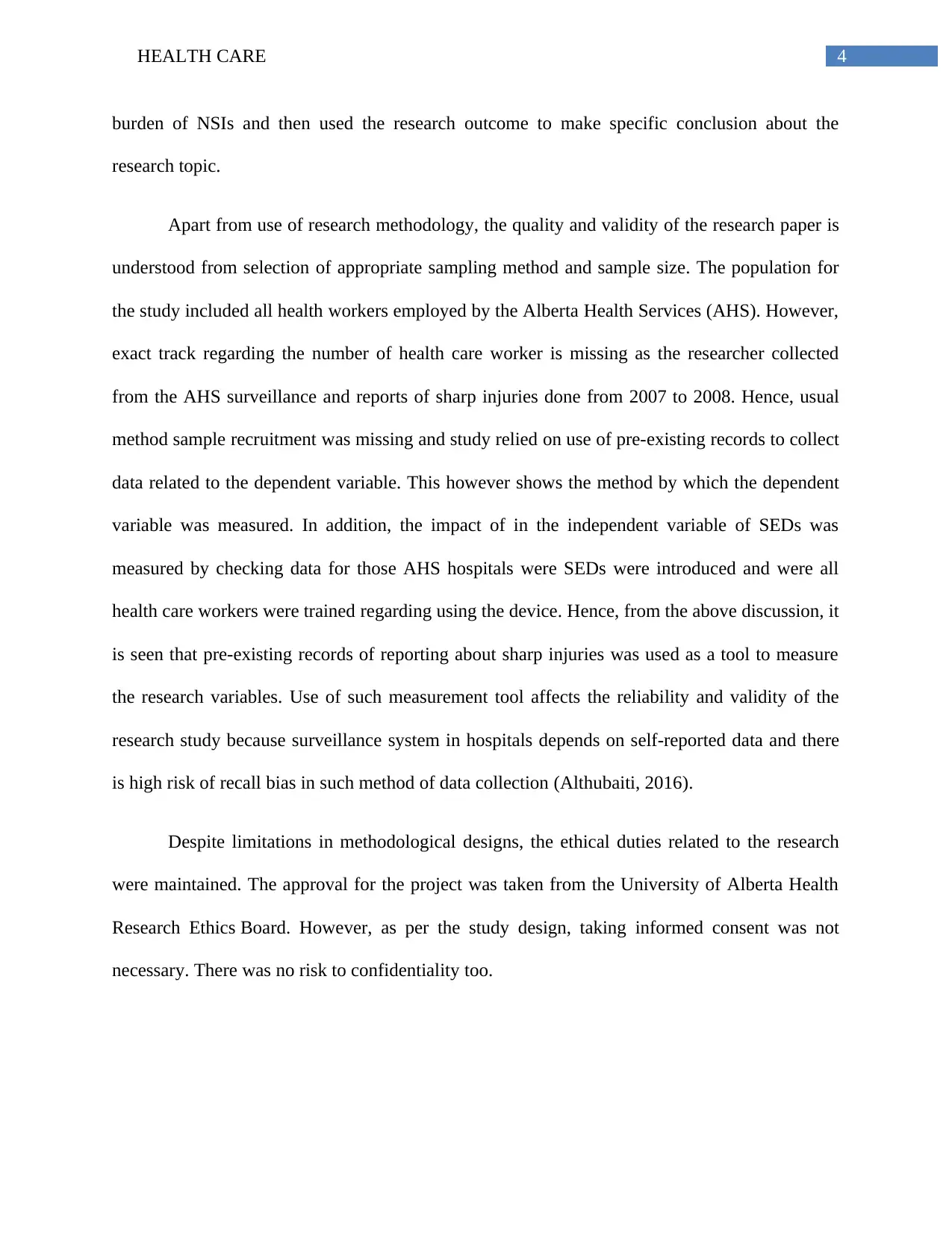
4HEALTH CARE
burden of NSIs and then used the research outcome to make specific conclusion about the
research topic.
Apart from use of research methodology, the quality and validity of the research paper is
understood from selection of appropriate sampling method and sample size. The population for
the study included all health workers employed by the Alberta Health Services (AHS). However,
exact track regarding the number of health care worker is missing as the researcher collected
from the AHS surveillance and reports of sharp injuries done from 2007 to 2008. Hence, usual
method sample recruitment was missing and study relied on use of pre-existing records to collect
data related to the dependent variable. This however shows the method by which the dependent
variable was measured. In addition, the impact of in the independent variable of SEDs was
measured by checking data for those AHS hospitals were SEDs were introduced and were all
health care workers were trained regarding using the device. Hence, from the above discussion, it
is seen that pre-existing records of reporting about sharp injuries was used as a tool to measure
the research variables. Use of such measurement tool affects the reliability and validity of the
research study because surveillance system in hospitals depends on self-reported data and there
is high risk of recall bias in such method of data collection (Althubaiti, 2016).
Despite limitations in methodological designs, the ethical duties related to the research
were maintained. The approval for the project was taken from the University of Alberta Health
Research Ethics Board. However, as per the study design, taking informed consent was not
necessary. There was no risk to confidentiality too.
burden of NSIs and then used the research outcome to make specific conclusion about the
research topic.
Apart from use of research methodology, the quality and validity of the research paper is
understood from selection of appropriate sampling method and sample size. The population for
the study included all health workers employed by the Alberta Health Services (AHS). However,
exact track regarding the number of health care worker is missing as the researcher collected
from the AHS surveillance and reports of sharp injuries done from 2007 to 2008. Hence, usual
method sample recruitment was missing and study relied on use of pre-existing records to collect
data related to the dependent variable. This however shows the method by which the dependent
variable was measured. In addition, the impact of in the independent variable of SEDs was
measured by checking data for those AHS hospitals were SEDs were introduced and were all
health care workers were trained regarding using the device. Hence, from the above discussion, it
is seen that pre-existing records of reporting about sharp injuries was used as a tool to measure
the research variables. Use of such measurement tool affects the reliability and validity of the
research study because surveillance system in hospitals depends on self-reported data and there
is high risk of recall bias in such method of data collection (Althubaiti, 2016).
Despite limitations in methodological designs, the ethical duties related to the research
were maintained. The approval for the project was taken from the University of Alberta Health
Research Ethics Board. However, as per the study design, taking informed consent was not
necessary. There was no risk to confidentiality too.
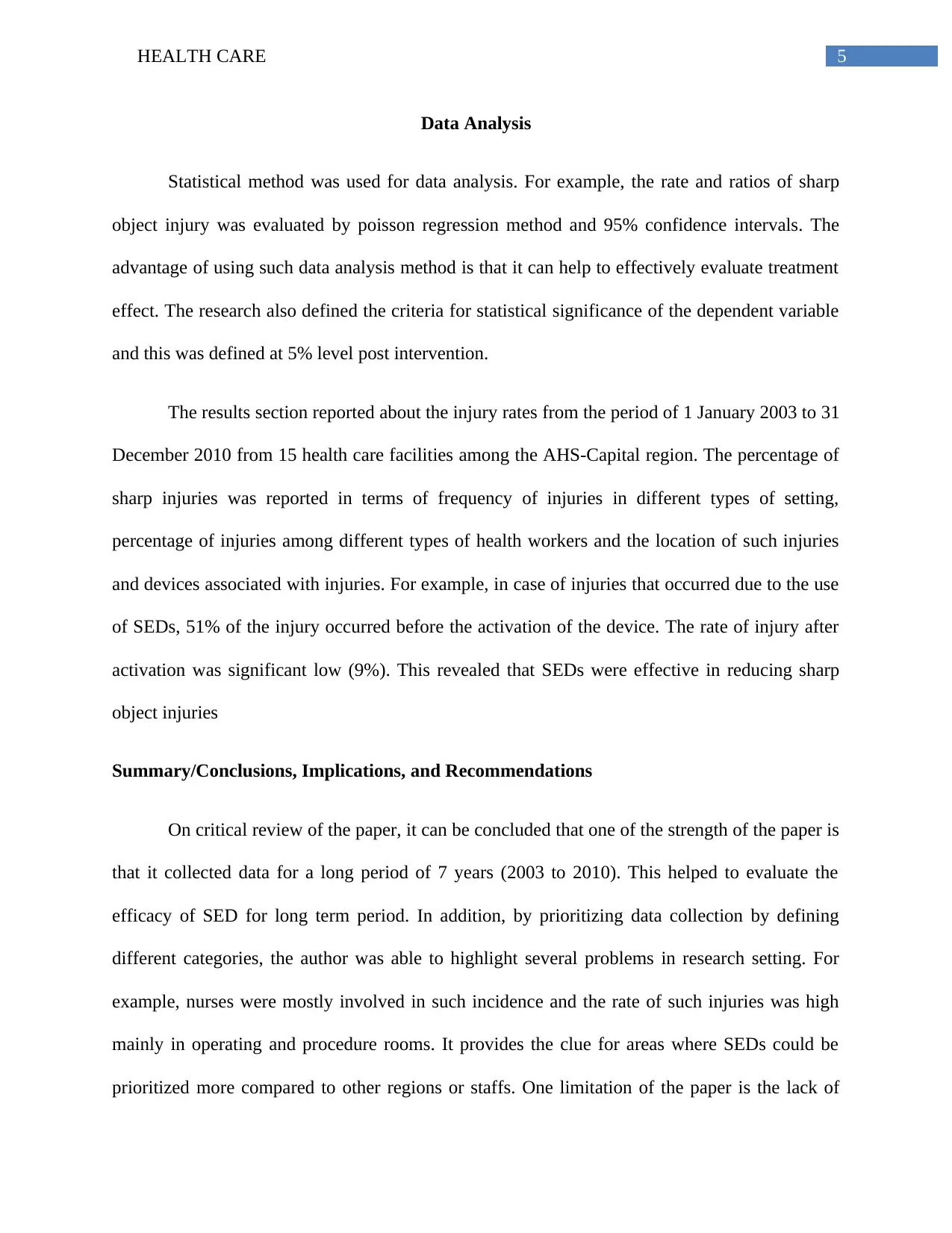
5HEALTH CARE
Data Analysis
Statistical method was used for data analysis. For example, the rate and ratios of sharp
object injury was evaluated by poisson regression method and 95% confidence intervals. The
advantage of using such data analysis method is that it can help to effectively evaluate treatment
effect. The research also defined the criteria for statistical significance of the dependent variable
and this was defined at 5% level post intervention.
The results section reported about the injury rates from the period of 1 January 2003 to 31
December 2010 from 15 health care facilities among the AHS-Capital region. The percentage of
sharp injuries was reported in terms of frequency of injuries in different types of setting,
percentage of injuries among different types of health workers and the location of such injuries
and devices associated with injuries. For example, in case of injuries that occurred due to the use
of SEDs, 51% of the injury occurred before the activation of the device. The rate of injury after
activation was significant low (9%). This revealed that SEDs were effective in reducing sharp
object injuries
Summary/Conclusions, Implications, and Recommendations
On critical review of the paper, it can be concluded that one of the strength of the paper is
that it collected data for a long period of 7 years (2003 to 2010). This helped to evaluate the
efficacy of SED for long term period. In addition, by prioritizing data collection by defining
different categories, the author was able to highlight several problems in research setting. For
example, nurses were mostly involved in such incidence and the rate of such injuries was high
mainly in operating and procedure rooms. It provides the clue for areas where SEDs could be
prioritized more compared to other regions or staffs. One limitation of the paper is the lack of
Data Analysis
Statistical method was used for data analysis. For example, the rate and ratios of sharp
object injury was evaluated by poisson regression method and 95% confidence intervals. The
advantage of using such data analysis method is that it can help to effectively evaluate treatment
effect. The research also defined the criteria for statistical significance of the dependent variable
and this was defined at 5% level post intervention.
The results section reported about the injury rates from the period of 1 January 2003 to 31
December 2010 from 15 health care facilities among the AHS-Capital region. The percentage of
sharp injuries was reported in terms of frequency of injuries in different types of setting,
percentage of injuries among different types of health workers and the location of such injuries
and devices associated with injuries. For example, in case of injuries that occurred due to the use
of SEDs, 51% of the injury occurred before the activation of the device. The rate of injury after
activation was significant low (9%). This revealed that SEDs were effective in reducing sharp
object injuries
Summary/Conclusions, Implications, and Recommendations
On critical review of the paper, it can be concluded that one of the strength of the paper is
that it collected data for a long period of 7 years (2003 to 2010). This helped to evaluate the
efficacy of SED for long term period. In addition, by prioritizing data collection by defining
different categories, the author was able to highlight several problems in research setting. For
example, nurses were mostly involved in such incidence and the rate of such injuries was high
mainly in operating and procedure rooms. It provides the clue for areas where SEDs could be
prioritized more compared to other regions or staffs. One limitation of the paper is the lack of
⊘ This is a preview!⊘
Do you want full access?
Subscribe today to unlock all pages.

Trusted by 1+ million students worldwide
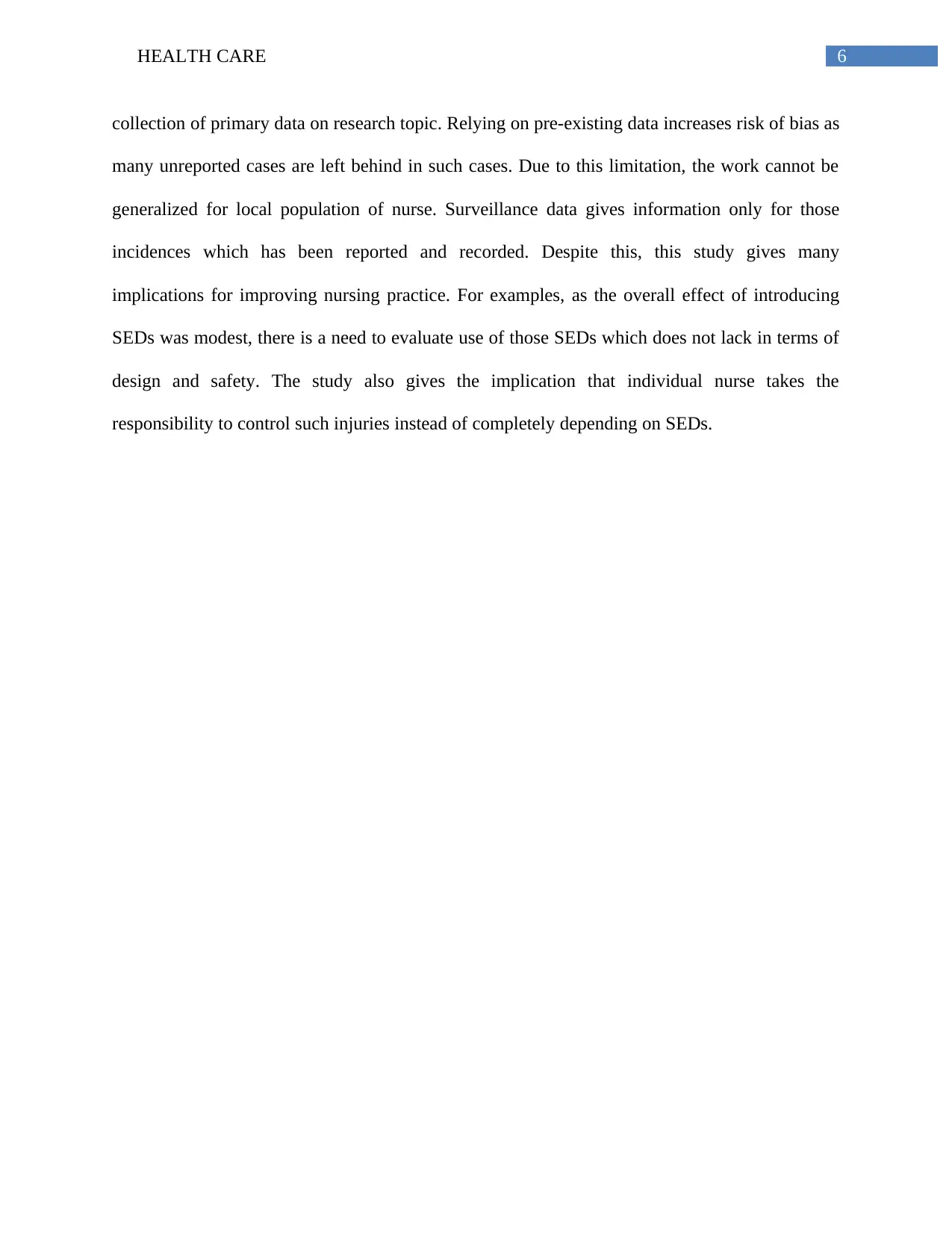
6HEALTH CARE
collection of primary data on research topic. Relying on pre-existing data increases risk of bias as
many unreported cases are left behind in such cases. Due to this limitation, the work cannot be
generalized for local population of nurse. Surveillance data gives information only for those
incidences which has been reported and recorded. Despite this, this study gives many
implications for improving nursing practice. For examples, as the overall effect of introducing
SEDs was modest, there is a need to evaluate use of those SEDs which does not lack in terms of
design and safety. The study also gives the implication that individual nurse takes the
responsibility to control such injuries instead of completely depending on SEDs.
collection of primary data on research topic. Relying on pre-existing data increases risk of bias as
many unreported cases are left behind in such cases. Due to this limitation, the work cannot be
generalized for local population of nurse. Surveillance data gives information only for those
incidences which has been reported and recorded. Despite this, this study gives many
implications for improving nursing practice. For examples, as the overall effect of introducing
SEDs was modest, there is a need to evaluate use of those SEDs which does not lack in terms of
design and safety. The study also gives the implication that individual nurse takes the
responsibility to control such injuries instead of completely depending on SEDs.
Paraphrase This Document
Need a fresh take? Get an instant paraphrase of this document with our AI Paraphraser
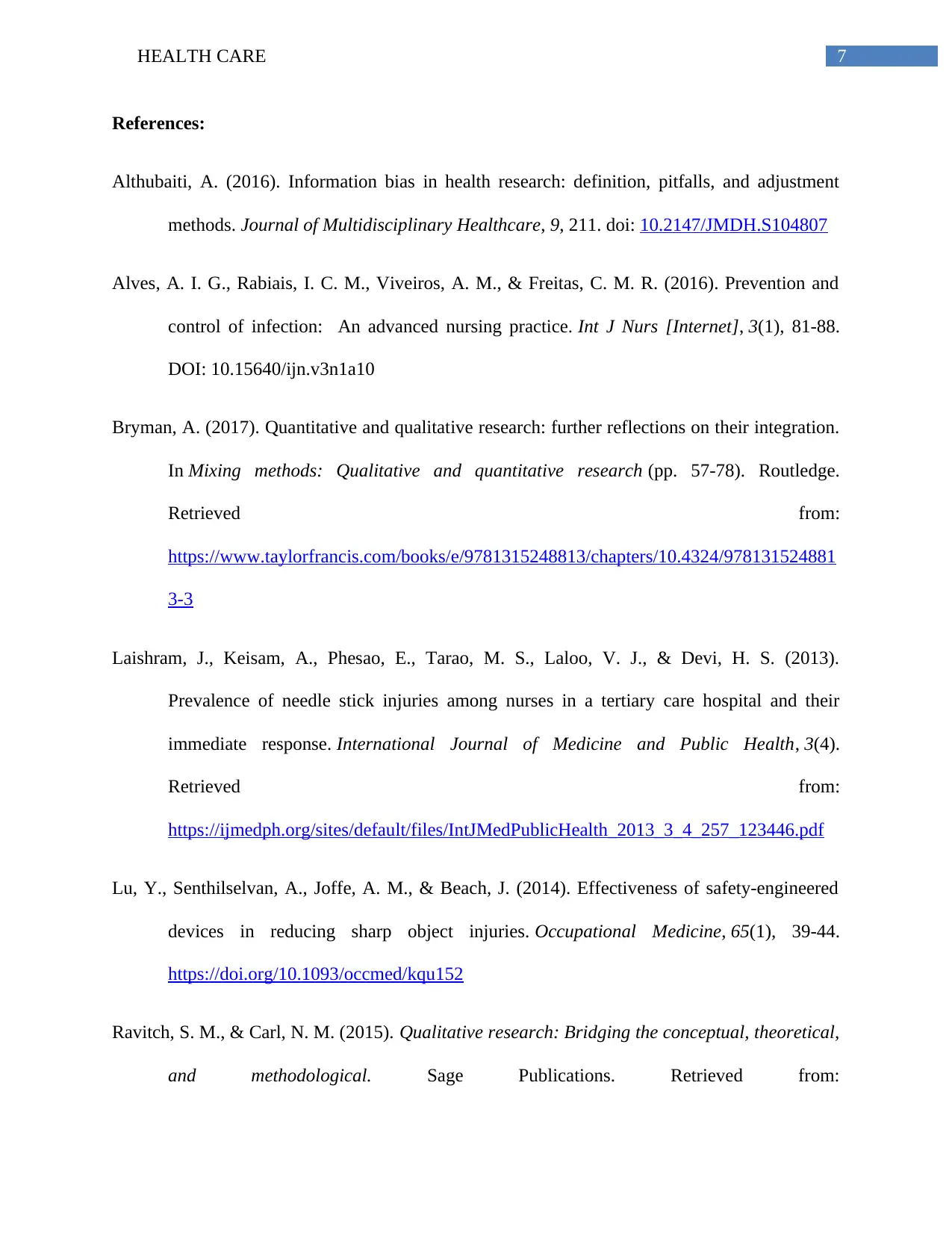
7HEALTH CARE
References:
Althubaiti, A. (2016). Information bias in health research: definition, pitfalls, and adjustment
methods. Journal of Multidisciplinary Healthcare, 9, 211. doi: 10.2147/JMDH.S104807
Alves, A. I. G., Rabiais, I. C. M., Viveiros, A. M., & Freitas, C. M. R. (2016). Prevention and
control of infection: An advanced nursing practice. Int J Nurs [Internet], 3(1), 81-88.
DOI: 10.15640/ijn.v3n1a10
Bryman, A. (2017). Quantitative and qualitative research: further reflections on their integration.
In Mixing methods: Qualitative and quantitative research (pp. 57-78). Routledge.
Retrieved from:
https://www.taylorfrancis.com/books/e/9781315248813/chapters/10.4324/978131524881
3-3
Laishram, J., Keisam, A., Phesao, E., Tarao, M. S., Laloo, V. J., & Devi, H. S. (2013).
Prevalence of needle stick injuries among nurses in a tertiary care hospital and their
immediate response. International Journal of Medicine and Public Health, 3(4).
Retrieved from:
https://ijmedph.org/sites/default/files/IntJMedPublicHealth_2013_3_4_257_123446.pdf
Lu, Y., Senthilselvan, A., Joffe, A. M., & Beach, J. (2014). Effectiveness of safety-engineered
devices in reducing sharp object injuries. Occupational Medicine, 65(1), 39-44.
https://doi.org/10.1093/occmed/kqu152
Ravitch, S. M., & Carl, N. M. (2015). Qualitative research: Bridging the conceptual, theoretical,
and methodological. Sage Publications. Retrieved from:
References:
Althubaiti, A. (2016). Information bias in health research: definition, pitfalls, and adjustment
methods. Journal of Multidisciplinary Healthcare, 9, 211. doi: 10.2147/JMDH.S104807
Alves, A. I. G., Rabiais, I. C. M., Viveiros, A. M., & Freitas, C. M. R. (2016). Prevention and
control of infection: An advanced nursing practice. Int J Nurs [Internet], 3(1), 81-88.
DOI: 10.15640/ijn.v3n1a10
Bryman, A. (2017). Quantitative and qualitative research: further reflections on their integration.
In Mixing methods: Qualitative and quantitative research (pp. 57-78). Routledge.
Retrieved from:
https://www.taylorfrancis.com/books/e/9781315248813/chapters/10.4324/978131524881
3-3
Laishram, J., Keisam, A., Phesao, E., Tarao, M. S., Laloo, V. J., & Devi, H. S. (2013).
Prevalence of needle stick injuries among nurses in a tertiary care hospital and their
immediate response. International Journal of Medicine and Public Health, 3(4).
Retrieved from:
https://ijmedph.org/sites/default/files/IntJMedPublicHealth_2013_3_4_257_123446.pdf
Lu, Y., Senthilselvan, A., Joffe, A. M., & Beach, J. (2014). Effectiveness of safety-engineered
devices in reducing sharp object injuries. Occupational Medicine, 65(1), 39-44.
https://doi.org/10.1093/occmed/kqu152
Ravitch, S. M., & Carl, N. M. (2015). Qualitative research: Bridging the conceptual, theoretical,
and methodological. Sage Publications. Retrieved from:
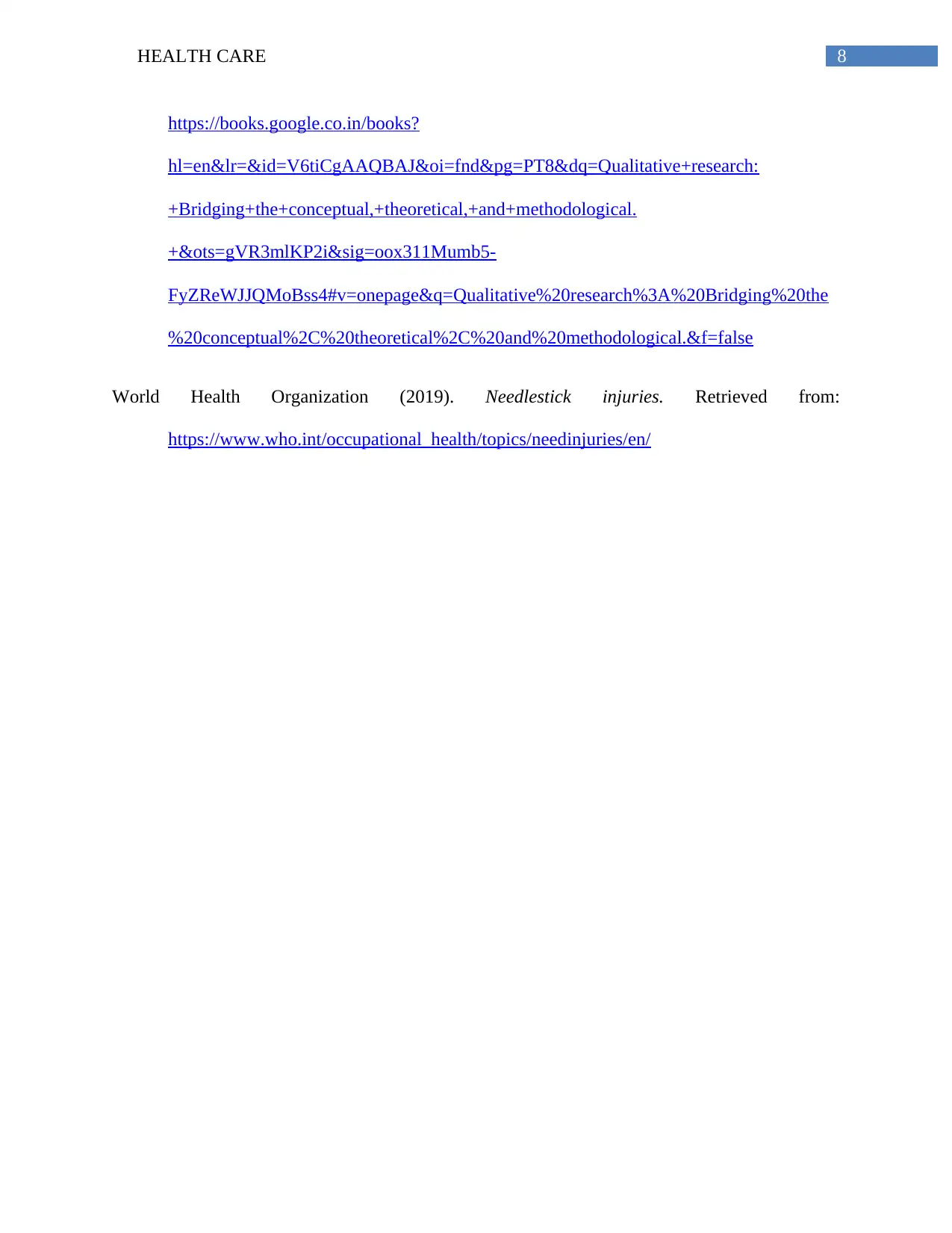
8HEALTH CARE
https://books.google.co.in/books?
hl=en&lr=&id=V6tiCgAAQBAJ&oi=fnd&pg=PT8&dq=Qualitative+research:
+Bridging+the+conceptual,+theoretical,+and+methodological.
+&ots=gVR3mlKP2i&sig=oox311Mumb5-
FyZReWJJQMoBss4#v=onepage&q=Qualitative%20research%3A%20Bridging%20the
%20conceptual%2C%20theoretical%2C%20and%20methodological.&f=false
World Health Organization (2019). Needlestick injuries. Retrieved from:
https://www.who.int/occupational_health/topics/needinjuries/en/
https://books.google.co.in/books?
hl=en&lr=&id=V6tiCgAAQBAJ&oi=fnd&pg=PT8&dq=Qualitative+research:
+Bridging+the+conceptual,+theoretical,+and+methodological.
+&ots=gVR3mlKP2i&sig=oox311Mumb5-
FyZReWJJQMoBss4#v=onepage&q=Qualitative%20research%3A%20Bridging%20the
%20conceptual%2C%20theoretical%2C%20and%20methodological.&f=false
World Health Organization (2019). Needlestick injuries. Retrieved from:
https://www.who.int/occupational_health/topics/needinjuries/en/
⊘ This is a preview!⊘
Do you want full access?
Subscribe today to unlock all pages.

Trusted by 1+ million students worldwide
1 out of 9
Related Documents
Your All-in-One AI-Powered Toolkit for Academic Success.
+13062052269
info@desklib.com
Available 24*7 on WhatsApp / Email
![[object Object]](/_next/static/media/star-bottom.7253800d.svg)
Unlock your academic potential
Copyright © 2020–2025 A2Z Services. All Rights Reserved. Developed and managed by ZUCOL.





